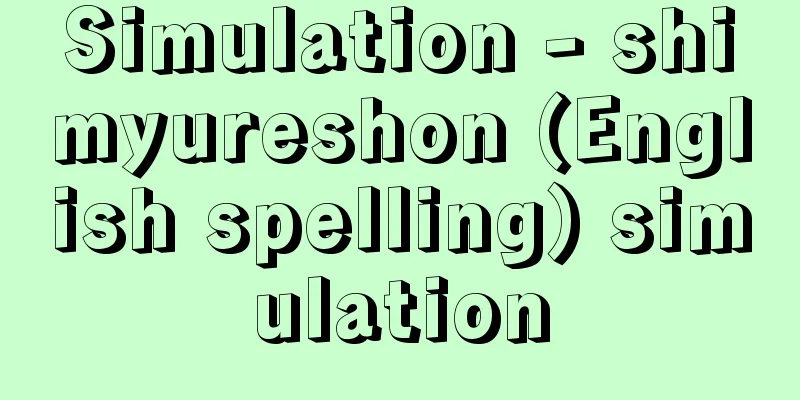Simulation - shimyureshon (English spelling) simulation

|
Originally, the meaning of the word "simulation" was "to pretend or imitate," but today, as a scientific and technical term, it has come to mean a general term for model experiments using numerical or physical models of various phenomena. It can also be translated as "mock experiment," but it is generally used in its original form. Simulation technology is used in a wide range of social phenomena, not only in natural sciences and engineering, but also in economics and other fields. Needless to say, the basis for its development was the practical application and widespread use of electronic computers since the 1950s. A device that executes simulations is called a simulator, and is used in research and training. In simulations using mathematical models, the simulation program itself and the language in which the simulation program is written are both called simulators. Simulation technologies that are widely used today can be broadly categorized into the following four types based on the characteristics of their model configuration. (1) A method in which a model of a real system is made and experiments are actually conducted. Examples of this method include making a model of a harbor or coastal area and running water through it to analyze tidal currents and examine the diffusion of pollutants, as well as wind tunnel experiments for aircraft design. These are known as scale models. (2) A method of investigating something that has equivalent properties but is a different substance. Examples of this method include investigating the vibration characteristics of a mechanical (machine) system by replacing it with an electric circuit that has the same properties, or building a model to understand the movements of passengers at a station and observing the flow of passengers by replacing it with a highly viscous fluid. These are called analog models. (3) Computer experiments in which a computer program is written based on a mathematical model and a calculation algorithm is used to simulate the quantities of a target system on an electronic computer. This is widely used in urban road traffic systems, material distribution systems, and production management systems, and also in computer experiments conducted to investigate the physical properties of liquid systems composed of molecular groups. When we say computer simulation, we usually mean simulations using digital models, particularly of mathematical models. (4) Experiments with systems that involve human judgment, such as business games. In reality, there is no clear distinction between the four types above, and they are often combined together. Of the above, the type (3) is the most prevalent today, and the following description will be centered around it. [Arakawa Hiroshi] Model system configuration and techniques in simulationWhen running a simulation on a computer, it is first necessary to model the target system. This model is not something concrete like the above (1), but an abstract model (see above (3)) consisting of an array of numerical values or variables. With this numerical model (digital model), the issue is how to simulate the passage of time, i.e., real time, in order to grasp the target system or phenomenon, and from that point of view, two model construction methods have been devised: the "continuous change model" and the "discrete change model." The former describes the change in the target system by considering time as a quantity that changes continuously (at infinitesimal equal time intervals), while the latter grasps the key points of the change in the phenomenon of the target system and connects them to depict it. Programs for running simulations can be written using general-purpose programming languages used in normal calculations, such as FORTRAN for scientific and technical calculations and ALGOL for business processing. However, simulation calculations generally involve simultaneous and parallel phenomena (computers in widespread use today are basically serial machines), so the programs become complicated. For this reason, dedicated "simulation programming languages" have been developed (these are called simulators or system simulators). Two types of simulation languages have also been developed in response to the two model construction methods mentioned above. One of these, the "continuous system simulator," originated from an attempt to run calculations such as those used by analog computers to find numerical solutions to differential equations on digital computers, and has been under development since the mid-1950s. Currently, widely used languages include DYNAMO (Dynamic Model, 1962) and CSMP (Continuous System Modeling Program, 1967). Other representative examples of "discrete system simulators" include GPSS (General Purpose System Simulator, 1961) and SIMSCRIPT (Simulation Scriptor, 1961), with GPSS being the most widely used. Below, we will focus on discrete system simulators and discuss their characteristics compared to general-purpose programming languages. There are two ways to express a system: still images and animation. We consider what appears in basic aspects and what properties they have, organize and express them (still images), and then connect them to create animation. In SIMSCRIPT, the elements that make up a system are called entities, and are divided into permanent elements and temporary elements. For example, in a road traffic system, roads, intersections, and traffic lights are permanent elements, while vehicles and pedestrians are temporary elements. Each of these has attributes, which are displayed. This is a general static expression technique. In GPSS, temporary elements are called transactions, which are "objects that move through the system over time," and represent vehicles, pedestrians, and aircraft, and in a communication system, telegrams. Permanent elements are further classified into two categories: storage and facility. "Equipment or facilities that can receive or be used by multiple transactions at the same time" (such as parking lots, warehouses, and classrooms, where the corresponding transactions are vehicles, goods, and students) are storage, while "equipment or facilities that can only be used by a single transaction at the same time" are facilities (such as telephones and service desks, where the corresponding transactions are callers and customers). "Attributes" are also defined for transactions, storage, and facilities. Consider how the system changes over time based on the above model representation. Permanent elements do not change, but their characteristics do (a parking lot does not change, but the number of cars parked there does). Temporary elements move and appear and disappear. Simulation programs describe these changes over time, and their description methods can be broadly divided into three types: transaction-centered description, event-centered description, and process-centered description. GPSS takes a transaction-centered approach and follows the movement of the transaction to see the time-dependent changes in the system. SIMSCRIPT was originally an event-centered description, but its improved version has moved to a process-centered description. A GPSS program is composed of basic instructions called "block instructions," and a corresponding "block diagram" is prepared, which is, so to speak, the path along which the transactions flow. The model described in the block diagram is coded and input into a computer to execute the simulation. Each of these simulation languages has its own model construction concept, and the user constructs the model according to that concept. We have looked at simulation models from the perspective of model construction, but looking at the causal characteristics of the process of change in the system, they can be divided into "deterministic models" and "uncertain models" (probabilistic models, stochastic models) in which some or all of the changes can only be described probabilistically. Almost all changes in real systems contain probabilistic elements. Computer simulations of probabilistic models are performed using the Monte Carlo Method. This method involves generating "uniform random numbers" using a computer, using them to create random numbers that follow a given distribution, running a simulation using these random numbers as inputs or controls for the system, and obtaining a conclusion or average value with a probability attached. The forerunner of simulation in the modern sense is the Monte Carlo simulation of neutron diffusion in fissionable material conducted at Los Alamos by von Neumann and Stanislaw Ulam (1909-1984) at the end of World War II, and the Monte Carlo method continues to play an important role in simulation techniques to this day. In simulation modeling techniques, the problem of "queuing" often plays an important role. As the name suggests, this is the queue at a public telephone or service window, and is a problem of great generality as an optimum value problem when viewed from the perspectives of both the capacity of the service facility and the lack of information and competition for customers. [Arakawa Hiroshi] Simulation application examplesSimulations are effective when the system to be studied is so complex or large that (1) an analytical solution cannot be found, (2) experimental observations would take too much time or money to actually carry out experiments, and (3) the experimental conditions are so extreme or dangerous (radioactivity, high temperature, etc.) that experiments are impossible, (4) the subject is nature, a region, or society, etc., and experiments would be essentially impossible, (5) the subject is a one-time event, etc. In reality, these conditions often overlap. [Arakawa Hiroshi] Simulation in the field of traffic and transportation systemsThe development of transportation networks, including automobiles, railways, and airplanes, is a defining feature of the modern era. The management and control of these transportation systems is carried out as a system centered on computers, making simulation technology indispensable. In everyday life, simulation is the most effective way to find out what kind of signal display is effective in road traffic systems, and GPSS has been widely used. This is a typical example of computer simulation using a numerical model. TRACSS (Traffic Control System Simulator) is a new system simulator developed in Japan specifically for road traffic systems, which is contributing to the design of traffic control systems. Needless to say, Shinkansen operation management is carried out by computer systems. The Shinkansen Traffic Simulation System (STRATS) was developed as a system simulator to effectively and appropriately carry out operation rescheduling and planning, and is also used as a training simulator. In the field of air traffic control, for example, the problem of waiting for takeoff and landing is a typical problem of the above-mentioned queue, and the rationalization of air traffic control has long been taken up as a subject of simulation technology. [Arakawa Hiroshi] Training SimulatorThey are used for training in piloting and driving aircraft and trains, and in the operation of chemical and nuclear plants. Aircraft flight simulators are a typical example, and are so-called hybrid models that combine a physical model with a numerical model in the computer that controls it. The most advanced example is the Space Shuttle. It must decelerate from a speed of Mach 25 when landing and land 4,000 miles (about 6,437 km) away from the point of re-entry into the atmosphere without power, and it is only through simulators that it can be trained. This is why it is said that the success of the simulation was everything in the Space Shuttle program. Training by simulation, along with flight simulators, is important in the field of process operations such as chemical and nuclear plants, but this field developed later than flight simulators. The problem with these plant systems is how to respond in the event of an accident, and there is no other way to train for this than through simulation. Further development of simulation technology is required, and this in itself is of great significance. [Arakawa Hiroshi] Applications to industrial and engineering problemsThe application of Monte Carlo theory to process operation systems is a typical example, but to give some other representative examples, the earliest developed simulations for industrial problems were in production planning, process control, and inventory problems, and they are also areas in which queuing theory is applied, along with service window problems. In the field of power engineering, accidents caused by lightning strikes on power transmission lines are a serious problem, and simulations using the Monte Carlo method are being carried out to find out the rate of accidents caused by lightning strikes in power transmission and distribution systems. [Arakawa Hiroshi] Application to natural science researchSimulations using Monte Carlo methods, molecular dynamics methods, and other techniques have contributed greatly to solving problems that cannot be solved analytically in fields such as cooperative phenomena such as phase transitions in solid state physics, liquid theory (equation of state and dynamic properties), and plasma physics. [Arakawa Hiroshi] Application to environmental and ecosystem problems, social phenomena, etc.Simulation is a basic method of "systems engineering" and can be applied to any system as long as the target system is treated as a "system." For example, the "Club of Rome Report" was conducted by a group at MIT (Massachusetts Institute of Technology) in the United States, who set up a "world model" in which the entire Earth was treated as a spaceship, and conducted a simulation. Similarly, simulations of China's population problems and simulations of the "urban system" of Boston have been conducted in the United States. These are huge and complex systems, so naturally the input parameter settings involve simplification. Another problem is how to use the results. The problem is the purpose of simulations of military issues, and "war games" are a prime example of this. If such simulations are conducted for a region or city, for example as part of an environmental assessment, and are based on sufficient survey data prior to the formulation of local plans, then they can be meaningful as predictive data. [Arakawa Hiroshi] Application to the field of managementAfter the Second World War, scientific management and planning methods, such as operations research, were introduced into the field of business management. Simulations were used as one of the methods to solve various management problems that involve uncertain factors, such as process management, inventory management, production planning, and sales strategies. In these problems, many factors are intricately interrelated and each of them involves uncertain factors, so it is often difficult to predict the overall outcome. Furthermore, if the results of an action taken without a clear prediction are unsuccessful, it can be fatal to the company. Therefore, before putting these plans or tasks into action, simulations are performed to roughly grasp the results. Sometimes, simulations are performed using small-scale equipment that resembles the actual situation, but in many cases, computers are used. Such equipment and computer programs used in simulations are called simulators. When using a computer, for example, to represent events that occur probabilistically, methods such as generating random numbers within the computer can be used to experimentally observe events that occur in reality. In addition, computer languages such as GPSS, SIMSCRIPT, and DYNAMO have been developed for such simulation work (strictly speaking, they belong to the category of application programs that are one level higher than general-purpose languages such as FORTRAN and COBOL), and have been in practical use for a long time. Furthermore, the use of simulation in the field of management has occupied an important position in the education and training curriculum for businessmen and managers during the heyday of business schools after World War II, mainly in the United States, and the educational method is called business games or simulation games and has become widely used. In this method, students are first divided into several hypothetical company management teams and placed in a market competition situation between companies. Then, as the management team of each student belongs to a model company, they set up a model of the company organization such as sales, production, technology, finance, and personnel, the interrelationships between them, and the decision-making method, etc., and then, under various uncertain factors such as demand, macroeconomics, and research and development as random variables, they experiment with the management strategy set by each model company to see what kind of financial statements will show its management performance, as if they were actually running a company. This allows students to learn about individual subjects such as marketing, business management, financial management, and corporate accounting that they have studied in other curricula in an organic way in the context of actual business dynamics, and also allows them to experience in a short period of time in the classroom how a specific business strategy affects the overall business performance through a business organization, without the enormous real-world risk of strategic errors. This is the great advantage of simulation, and for this reason, this educational method has been used today as one of the core curricula in business schools and other institutions as it has produced great results in management education. [Tadashi Takashima] Economic applicationsSimulations in the field of economics are primarily performed for economic forecasting and policy analysis using econometrics. They are performed exclusively using computer programs, and due to the nature of the subject, it is generally not conceivable to use physical devices in this field. In addition, due to the complexity and diversity of the system, and the uncertainty of the behavior of individual factors, it is generally not possible to describe the real economic system as a strict deterministic mathematical formula and derive a general solution for all variables based on that formula using analytical methods. First, the main interrelationships between the various factors (= economic variables) that make up the economic system to be analyzed or predicted are constructed as a probabilistic mathematical model based on economic theory. Then, according to this model, the specific relationships are quantitatively estimated using past statistical data. This is called a structural equation system, which expresses the real economy as a basic structure according to the purpose of analysis and shows it as a quantitative causal relationship. By using this system, it is possible to know in advance the economic effects that will occur due to various policy changes by arbitrarily changing policy variables (government spending, policy interest rates, etc.), and by assuming future values of exogenous variables (in the case of the Japanese economy, world trade volume, imported primary product prices, etc.), it is possible to predict the future state of the economy under those conditions. In forecasting and policy analysis, there is a difference in how variables in the economic model are handled in each simulation. An econometric model is a probabilistic mathematical model that depicts the movement of the real economy as an interdependent relationship between important variable factors (economic variables). The economic variables that make up the econometric model are divided into endogenous variables that are determined in the market as economic causal relationships, and exogenous variables (natural, political, policy conditions, etc.) that are determined outside the market, based on their economic characteristics. In economic forecasting simulations, if the assumed conditions are given as numerical values for the exogenous variables, it is determined what endogenous variables (consumption, employment, prices, imports and exports, economic growth, etc.) will represent the actual economic situation, assuming that these conditions have been realized. In contrast, in policy analysis simulations, there are policy goals, such as the desired levels of economic growth rate, consumer prices, unemployment rate, etc., and the purpose is to experimentally find out what economic policies should be implemented to achieve these goals. Therefore, here, some of the endogenous variables in the forecasting simulation are converted into exogenous variables, as they have set target values as policy variables. At the same time, some of the exogenous variables are transformed into endogenous variables as variables that need to be determined in order to achieve those policy goals. Simulations are run based on this reconstruction of the economic variables, and economic policies that are consistent with the set goals can be experimentally identified. If the values of the policy variables obtained as the solution are deemed impossible to achieve in the real environment, the policy goals are changed and the simulations are repeated to find a combination of achievable policy goals and policy measures that are consistent with them. In the application of simulation to the economic field, the advancement, development, and spread of computers, especially personal computers, and their various application software (SPSS, TSP, GAUSS, MATHEMATICA, EViews, STATA, etc.) since the 1990s has made it possible to realize the benefits of simulation in general, such as time and cost savings, risk avoidance, and obtaining prior information. However, it is also necessary to be fully aware of its limitations. In particular, when setting up an economic model, which is the starting point for economic simulation work, even if it is based on economic theory to the greatest extent possible, it is still a construction of the basic causal relationships of the real economy according to the modeler's ideas, and is not a perfect reproduction of the real economy itself. In addition, the economic theory on which it is based is always in development. Furthermore, even if the economic model is able to accurately depict the movements of the real economy, there is no guarantee that the constants (structural parameters), which are numerical values that concretely indicate the causal relationships between economic variables in the model, will remain unchanged in the future as long as economic phenomena are the result of human behavior. Naturally, changes in these parameters will directly affect the results of the simulation and affect its value as experimental information. This effect cannot be overlooked, particularly in predictive simulations, where we are faced with the tautology that correct predictions of the economy through simulations are predicated on correct predictions of the model (especially the structural parameters). [Tadashi Takashima] Simulations in International PoliticsSimulation in international politics is a new method of international political analysis that became popular in the United States around the end of the 1950s. It is an experiment using a model. Previously, international political research was mainly focused on international systems and institutions, and historical case studies based on international law and diplomatic history. This did not fully clarify the mechanisms and functions of policy-making, and also lacked predictability. The development of behavioral science after World War II had a major impact on the analysis of international politics. Advances in quantification, measurement theory, and non-parametric statistics led to efforts to quantitatively grasp international political phenomena and discover patterns. Simulation in international politics can be considered one aspect of this effort. It aims to construct general hypotheses by creating situations in a laboratory similar to real-life international politics and simulating political phenomena that cannot be repeated. There are three types of simulations: (1) computer simulations, (2) human-only simulations, and (3) human-computer collaborative simulations. Of these, the combination of human and computer simulations is said to be the most faithful reproduction of international political situations or conditions, and this type is currently being researched and tested. A representative example is the Internationa l Simulation (INS) developed by Harold Guetzkow (1915-2008) of Northwestern University. INS sets up five fictitious countries, each of which has its own policy makers (domestic policy maker IDM, later chief policy maker CDM, foreign policy maker EDM, military policy maker MDM, and person who tries to replace the policy maker ADM, etc.), and these subjects play their roles according to certain rules and procedures. In this case, differences in behavior due to differences in the subjects' cultures, nationalities, and personalities become an issue. The INS takes about an hour to complete, and alternates between two periods: budget determination, which is constrained by the program, and diplomatic development based on the subjects' free activities. The purpose of the INS is to extract and formulate hypotheses about the dynamic relationships in international politics in the first and second halves of the experiment. Simulations in international politics are useful for education, training, and model building, but it is said that the major issues for simulation in the future are coherence studies, which are the integration of models, and validation studies. The spread of high-performance personal computers and their network systems since the 1990s has made the aforementioned research and analysis of dynamics in international politics easier, and has produced great results. [Usui Hisakazu] になったんです。 English : The first thing you can do is to find the best one to do. "Material science through computer simulations: Molecular dynamics and Monte Carlo method" (1996, Kyoritsu Publishing)" by Kawazoe Yoshiyuki, Mikami Makoto et al. ▽ "Model simulation techniques" by Arisawa Makoto and Saito Tetsuya (1997, Kyoritsu Publishing)" by "Urban design and simulation: Techniques and tools" by Environmental Simulation Lab Research Group, Supervised by Ito Shigeru and compiled by Environmental Simulation Lab Research Group, "Easy Transport Simulation" (2000, published by Maruzen, published by Maruzen, by Nonami Hiroshi, "Kansai Gakuin University Faculty of Sociology Research Series: The influence of minorities in environmental issues: Experimental verification using simulation and gaming" by Kinoshita Kazuya, "Research on system evaluation methods using discrete simulations: Approach using production systems and simulations" by Dobunkan Publishing" by Kinoshita Kazuyaになったんです。 English: The first thing you can do is to find the best one to do . Econometrics (1999, Toyo Keizai Shinposha) ▽ Morito Susumu and Sakasegawa Hirotaka, System Simulation (2000, Asakura Shoten) ▽ Iijima Masaki, Ohama Keikazu, Ito Kazunori and Muto Akinori, Management Information Simulation for Decision Making (2000, Dobunkan Publishing) ▽ Seki Kanji, The Basics of International System Theory (1969, University of Tokyo Press) ▽ Seki Kanji, Global Simulation & Gaming: Towards Complex Geopolitics (1997, Science and Technology Fusion Promotion Foundation, Published by Honei) [Reference] | | | | | | | | | | | | | | | | | | | | | |Source: Shogakukan Encyclopedia Nipponica About Encyclopedia Nipponica Information | Legend |
|
本来、「シミュレーション」の語義は、「ふりをする、まねをすること」の意であるが、今日では、科学・技術用語として、諸事象に関する数値的あるいは物理的モデルによるモデル実験の総称を意味する語となっている。「模擬実験」などと訳されることもあるが、一般に原語のままで用いられることが多い。シミュレーション技術は、自然科学・工学ばかりでなく経済学など広く社会的諸事象にかかわって用いられている。その発展の基礎となったのは、いうまでもなく1950年代以降の電子計算機の実用化とその普及である。シミュレーションを実行する装置がシミュレーターであり、研究・訓練に用いられる。数学的モデルによるシミュレーションでは、シミュレーション・プログラムそれ自体や、シミュレーション・プログラムを組む言語もシミュレーターと称している。 今日、広範に行われているシミュレーション技術をそのモデル構成の特徴から大別すると、以下の4種類に類別される。 (1)現実のシステムの模型をつくって実際に実験をする方法で、港湾・海岸地域の模型を作製して水を流し、潮流の解析、汚染物質の拡散状況を調べる実験や、航空機設計のための風洞実験など、スケール・モデルと称されるものがこれに属する。 (2)現象的には対応する同等の特性をもっているが、物質としては異なるものを用いて調べる方法。力学(機械)系の振動特性を調べるために、対応した同等の特性を有する電気回路に置き換えて調べたり、駅で乗客の動きを知るために模型をつくり、乗客の流れを粘性の大きい流体に置き換えて観測する場合などがこれで、アナログ・モデル(類推モデル)といわれる。 (3)数学的モデルに基づいて、対象系の諸量について計算アルゴリズムをもとにコンピュータのプログラムを組み、電子計算機上でシミュレートする計算機実験。都市道路交通システム、物質流通システム、生産管理システムの場合など広く行われており、また分子集団で構成される液体系の物性を調べるために行われる計算機実験などもこの事例の一つである。通常、コンピュータ・シミュレーションというとき、この数学的モデルのうち、とくにデジタル・モデルによるシミュレーションをさしている。 (4)ビジネス・ゲームなど、いわゆるゲームとよばれる「人間の判断が介在する」システムに対する実験。 以上の4種類は、実際には明確な区別はなく、また以上のものがいくつか組み合わされた形で行われることが多い。以上のうち、今日、中心となっているのは(3)のタイプのものであり、以下の記述はそれを中軸として述べる。 [荒川 泓] シミュレーションにおけるモデル・システムの構成と技法コンピュータ上でシミュレーションを実行する場合、まず対象システムのモデル化が要求される。そのモデルは(前述(1)のようにまったく具体的なものではなくて)数値の配列、あるいは変数から構成される抽象的なモデル(前述(3))である。この数値モデル(デジタル・モデル)では、対象系あるいは現象をとらえるにあたって、その時間経過、すなわち実時間をどのようにシミュレートするかが問題であり、その点から「連続変化モデル」と「離散変化モデル」の二つのモデル構成法が考えられた。前者は、時間を連続的に(微小等時間間隔で)変化する量としてとらえて対象系の変化を記述するものであり、後者は、その対象系の事象の変化の問題とすべきポイントを押さえ、それをつないで描写するものである。 シミュレーションの実行のためのプログラムは、通常の計算で用いられる汎用(はんよう)プログラミング言語である科学技術計算用のFORTRAN(フォートラン)、事務処理用のALGOL(アルゴル)などを用いて組むことは可能であるが、シミュレーション計算では一般に同時並行現象などを含む(今日普及しているコンピュータは基本的にシリアル・マシン)ので、プログラムが複雑になる。そのため専用の「シミュレーション・プログラミング言語」が開発されている(これをシミュレーターあるいはシステム・シミュレーターという)。そして、先の二つのモデル構成法に対して、シミュレーション言語も2種開発されている。その一つの「連続システム・シミュレーター」は、もともとアナログコンピュータによる微分方程式の数値解を求める計算などをデジタルコンピュータで実行しようとする試みから出発したもので、1950年代なかばから開発されている。現在、広く用いられているものに、DYNAMO(Dynamic Model、1962)、CSMP(Continuous System Modeling Program、1967)などがある。いまひとつの「離散システム・シミュレーター」の代表例にGPSS(General Purpose System Simulator、1961)、SIMSCRIPT(Simulation Scriptor、1961)などがあり、GPSSはもっとも広く用いられてきた。 以下、離散システム・シミュレーターに限って、それが汎用プログラミング言語に比べてどのような特徴をもつかについて述べる。システムの表現には二つの観点、すなわち静画と動画とがある。基本の局面にどのようなものがどのような性質をもって現れるかを考え、それを整理して表現し(静画)、それをつないで動画化する。SIMSCRIPTでは、システムを構成する要素をエンティティentityといい、恒久要素と一時要素とに分ける。たとえば道路交通システムでは、道路・交差点・信号などが恒久要素であり、車両・歩行者などは一時要素である。それらにはそれぞれ属性attributeがあり、それが表示される。これは一般性をもった静的表現の技法である。GPSSでは、一時要素はトランザクションtransactionとよばれ、これは「時間の経過とともにシステムのなかを動く対象」であり、車両・歩行者・航空機や、通信システムであれば電文などを表現する。恒久要素は、さらにストーレジstorage、ファシリティfacilityの二つに分類される。「同時に複数個のトランザクションが入りうる、あるいは使用できる機器設備類」(駐車場・倉庫・教室など、対応するトランザクションは車両・商品・生徒など)がストーレジであり、「同時に単一のトランザクションのみが使用しうる機器設備類」がファシリティ(電話・サービス窓口など、対応するトランザクションは通話者・顧客など)である。トランザクション、ストーレジ、ファシリティにも「属性」が定義される。 以上のモデル表現のうえで、時間とともにシステムがどう変わるかを考える。恒久要素そのものは変化しないが、その特性は変わる(駐車場そのものは変化しないが、その中に駐車している車の数は変化する)。一時要素は運動をするうえに生じたり消滅したりする。時間の経過とともに、これらの変化を記述するのがシミュレーション・プログラムであり、その記述方式は大別して、トランザクション中心の記述、事象中心の記述、プロセス中心の記述の三つに分けられる。GPSSはトランザクション中心の考え方をとり、その動きに沿ってシステムの時間的変化をみるという形になっている。SIMSCRIPTは、当初、事象中心の記述であったが、その改良版ではプロセス中心に移ってきている。GPSSによるプログラムは、基本命令である「ブロック命令」で構成され、それに対応して「ブロック・ダイヤグラム」が準備されており、これがいわばトランザクションの流れる道である。ブロック・ダイヤグラムで記述されたモデルは、コーディングされ、計算機に入力されてシミュレーションを実行する。これらのシミュレーション言語には、固有のモデル構成概念が備わっており、使用者はそれに従ってモデルを構成することとなる。 以上、モデル構成の面からみてきたが、シミュレーション・モデルは、そのシステムの変化の過程の因果論的特徴からみて、「決定論的モデル」と、その変化の一部もしくは全部が確率論的にしか記述できない「不確定モデル」(確率的モデル、ストカスティック・モデル)とに分けられる。現実のシステムの変化は、ほとんどすべてがそのなかに確率的要素を含んでいる。確率的モデルに対するコンピュータ・シミュレーションは「モンテカルロ法」Monte Carlo Methodで行われる。この手法は、コンピュータで「一様乱数」を発生させ、それを用いて与えられた分布に従った乱数をつくりだし、システムの入力またはコントロールにその乱数を用いてシミュレーションを実行し、確率を伴った結論ないしは平均的数値を得るものである。そもそも現代の意味でのシミュレーションの嚆矢(こうし)とされるのが、第二次世界大戦末期、フォン・ノイマンやスタニスラウ・ウラムStanislaw Ulam(1909―1984)らにより、ロス・アラモスで行われた核分裂物質における中性子の拡散現象についてのモンテカルロ法によるシミュレーションであり、モンテカルロ法はシミュレーション技法において重要な比重を占め、今日に至っている。 シミュレーションのモデル技法において、「待ち行列」queuingの問題が重要な役割を果たす場合がしばしばおこる。これは、その名のとおり、公衆電話やサービス窓口における待ち合わせ行列そのものであって、サービス提供施設の容量、それに対して顧客にとっての情報不足と取り合い問題の両面からみたときの最適値問題として、きわめて大きな一般性を有する問題となる。 [荒川 泓] シミュレーション適用事例シミュレーションが有効性を発揮するのは、調べようとする対象系が複雑ないしは巨大すぎて、(1)解析的な解が求められない場合、(2)実験観測にあまりにも多くの時間もしくは費用を要して事実上実験できない場合、さらに(3)実験条件が極限状況ないしは危険(放射能・高温など)で実験が不可能の場合などであり、また(4)自然、地域、社会などを対象とするもので、本来、実験が不可能の場合、(5)本来、一回性の事象を対象とする場合、などである。実際にはこれらの条件が重なり合って現れることも多い。 [荒川 泓] 交通輸送システム分野におけるシミュレーション自動車、鉄道、航空機など交通網の発達はまさに現代を特徴づけるものである。これらの交通輸送システムの管制や制御は、コンピュータを中心とするシステムとして行われているので、そこではシミュレーション技術が不可欠である。身近なところでは、道路交通システムにおいて、いかなる信号表示が効果的であるかを知るためにはシミュレーションがもっとも有効であり、GPSSが多く用いられてきた。数値モデルによるコンピュータ・シミュレーションの典型例である。日本で開発された新しい道路交通システム専用のシステム・シミュレーターにTRACSS(Traffic Control System Simulator)があり、交通管制システムの設計に寄与している。 新幹線の運転管理は、いうまでもなくコンピュータ・システムで行われている。そこでは運転整理・計画を有効適切に行うためのシステム・シミュレーターとして新幹線トラフィック・シミュレーション・システム(STRATS)が開発され、訓練用シミュレーターとしても使われている。航空管制の分野では、たとえば離着陸の待ちの問題は、前述の待ち行列の典型的な問題であり、航空管制合理化は久しくシミュレーション技術の対象として取り上げられてきた。 [荒川 泓] 訓練用シミュレーター航空機、列車などの操縦・運転や、化学・原子力プラントなどのオペレーションの訓練に使われる。航空機フライト・シミュレーターはその代表的なもので、これは物理的なモデルと、それを制御するコンピュータのなかの数値的モデルとを組み合わせた、いわゆるハイブリッド(混合)モデルである。そのもっとも高度の例がスペースシャトルの場合である。これは、着陸時にマッハ25の速度から減速して、大気圏再突入時から4000マイル(約6437キロメートル)も離れた地点に着陸することを動力なしで、1回で成功させなければならず、その着陸技術の訓練はシミュレーターによるほかない。まさにシミュレーションの成功がスペースシャトル計画のすべてであったといわれるゆえんである。フライト・シミュレーターとともにシミュレーションによる訓練が重要な意味をもつのは、化学・原子力プラントなどのプロセス・オペレーションの分野であるが、これはフライト・シミュレーターより遅れて発達した。これらのプラント・システムにおける問題は、事故発生の場合の対応であり、その訓練はシミュレーションによる以外の方法はない。シミュレーション技術のいっそうの発展が要求されるとともに、そのこと自体が重要な意味をもっているといえる。 [荒川 泓] 産業および工学的諸問題への応用前記のプロセス・オペレーション・システムへの適用はその典型的事例であるが、その他のいくつかの代表的事例をあげると、産業における問題としてもっとも早く発達したのは、生産計画、工程管理、在庫問題におけるシミュレーションであり、サービス窓口問題とともに待ち行列理論の適用分野でもある。電力工学分野では、送電線への落雷による事故は重大な問題であるが、落雷による送配電システムの事故率などを知るためにモンテカルロ法によるシミュレーションが行われている。 [荒川 泓] 自然科学研究面への適用固体物理における相転移などの協力現象、液体論(状態方程式・動的物性)、プラズマ物理などの分野で、解析的に解けない問題に対してモンテカルロ法、分子動力学法などによるシミュレーションが行われ大きく寄与している。 [荒川 泓] 環境・生態系問題、社会的事象などへの適用シミュレーションは「システム工学」の基本的手法として、対象系を「システム」として扱う限りにおいて、どのような系にも適用できる。たとえば、「ローマ・クラブ・レポート」は、アメリカのMIT(マサチューセッツ工科大学)のグループが中心となって、地球全体を一つの宇宙船として「世界モデル」を設定し、シミュレーションを行ったものである。同じように中国の人口問題に関するシミュレーション、ボストン市を対象としての「都市システム」についてのシミュレーションなどが、アメリカで行われている。これらは、システムとして巨大かつ複雑であるので、入力パラメーター設定に当然単純化を伴うものである。また、その結果をどう使うかが問題である。目的がそもそも問題であるのは軍事問題についてのシミュレーションであり、「戦争ゲーム」はその最たるものである。 地域・都市などを対象として、たとえば環境アセスメントの一つとして、地域での諸計画の具体化に先だって、十分な調査データに基づいて行われるならば、そうしたシミュレーションは一つの予測データとして意味をもつものである。 [荒川 泓] 経営分野への応用第二次世界大戦後、オペレーションズ・リサーチに代表される科学的管理・計画手法が企業経営の分野に導入されたのに伴い、その手法の一つとして、工程管理、在庫管理、生産計画、販売戦略など、不確実要因を含む種々の経営問題に対して、シミュレーションが用いられるようになった。これらの問題では、多くの要因が入り組んで相互に関連しあい、しかもそれぞれが不確実的要素を伴うため、全体の結果を予測することが困難な場合が多い。また、明確な予測なしに実行した結果が不成功であった場合、事態は企業にとって致命的なものとなることもある。したがって、それらの計画や作業を実行に移す前に、その結果のおおよそを把握するためにシミュレーションが行われるのである。それは実際の状況に類似した小規模の装置を用いて行われることもあるが、多くの問題ではコンピュータを用いて行われる。シミュレーションに用いられるこのような装置やコンピュータ・プログラムのことをシミュレーターという。コンピュータを用いる場合、たとえば、確率的に発生する事象を表現するには、コンピュータ内で乱数を発生させるなどの手法を用いて、現実におこる事柄を実験的に観測することができるのである。また、このようなシミュレーション作業用のコンピュータ言語(厳密には、FORTRAN、COBOLなどの汎用(はんよう)言語より一段レベルを異にする応用プログラムに属するもの)として、GPSS、SIMSCRIPT、DYNAMOなどが開発されており、実際にすでに長く実用に供されてきている。さらに、経営分野におけるシミュレーションの利用は、アメリカを中心とする第二次世界大戦後のビジネス・スクール全盛のなかで、ビジネスマンや経営管理者層のための教育・訓練カリキュラムのなかで重要な位置を占めることになり、その教育手法はビジネス・ゲーム、あるいはシミュレーション・ゲームとよばれて広く用いられるに至っている。これはまず、学生をいくつかの仮想的企業経営陣に分けて企業間の市場競争状態のなかに置く。そして、学生はそれぞれの所属のモデル企業の経営陣として、営業、生産、技術、財務、人事等の企業組織とその間の相互関連、意思決定方式等をモデルとして設定し、そのもとで需要、マクロ経済、研究開発等、各種の不確定要素が確率変数として種々に与えられるなかで、各モデル企業の設定した経営戦略がいかなる財務諸表となってその経営成績が示されるかを、あたかも実際に企業経営を行うかのように実験するものである。これによって、学生は、他のカリキュラムとして学んだマーケティング、経営管理、財務管理、企業会計等の個別科目をその間の有機的関連として実際の経営動態のなかで習得することができるとともに、特定の経営戦略が経営組織のいかなる経路をとおして全体の経営成績に影響するかを教室のなかで短時間に、しかも戦略の誤りによる膨大な現実リスクを伴うことなしに、体験することができる。これがシミュレーションの大きなメリットであり、そのため、この教育手法は経営者教育に大きな成果を生むものとして、今日、ビジネス・スクールなどでの一つの中心的なカリキュラムとして使われている。 [高島 忠] 経済分野への応用経済分野におけるシミュレーションは、おもに計量経済学を用いてなされる経済予測および政策分析について行われる。それらはもっぱらコンピュータ・プログラムによるものであり、その対象の性質から、この分野で物理的装置を用いてすることは、一般には考えられない。また、システムとしての複雑性、多様性、個々の要因の行動の不確実性などから、現実経済の体系を厳密な確定的数学式として記述し、それに基づいてすべての変数についての一般解を解析的手法によって導くことも一般には不可能である。 まず、分析ないし予測の対象となる経済体系を構成する各種の要因(=経済変数)間の主要な相互関連を、経済理論を基礎として確率的数学モデルとして構成する。そして、そのモデルに従って、過去の統計データを用いて、その具体的な関係を数量的に推計する。これは、現実経済を分析目的に応じた基本的構造として表現し、それを数量的因果関係として示すものであり、構造方程式体系とよばれる。この体系を用いることにより、政策的変数(政府支出、政策金利など)を任意に変えてみることにより、さまざまな政策変更に伴って生ずるであろう経済効果をあらかじめ知ることができ、また、外生的変数(日本経済を対象とする場合には、世界の貿易量、輸入一次産品価格など)の将来値を想定することにより、その条件の下での将来の経済の姿を予測することができる。 予測と政策分析においては、それぞれのシミュレーションにおいて、経済モデルのなかの変数の取り扱いに違いがある。現実経済の動きを、重要な変動要因(経済変数)間の相互依存関係として確率的数学モデルとして描写したものが計量経済モデルであるが、それを構成する経済変数はその経済的特性から、まず、経済的因果関係として市場のなかで決まってくる内生変数とそれ以外の、市場の外で決められる外生変数(自然的・政治的・政策的条件など)とに分けられる。経済予測のシミュレーションにおいては、外生変数に想定される状況を数値として与えれば、それらの状況が実現したとの仮定の下で、経済実態がどのような内生変数(消費、雇用、物価、輸出入、経済成長など)として示されるかが決まってくる。これに対して、政策分析のシミュレーションにおいては、まず、経済成長率、消費者物価、失業率などをどの水準にしたいかというような政策目標があって、それらの目標を達成するためにはいかなる経済政策を実行すべきか、ということを実験的に知ることが目的である。したがって、ここでは、予測シミュレーションにおいて内生変数であったものの一部が政策変数として設定目標値をもつことになるため、外生変数に転化する。その一方で、外生変数の一部がそれらの政策目標を達成するために求められるべき変数として内生変数に転化する。このような経済変数の再構成の下でシミュレーションが行われ、設定目標に対する整合的な経済政策が実験的に知れるわけである。もし、解として得られた政策変数の値が現実環境の下で実現不可能と判断される場合には、政策目標を変更してシミュレーションを繰り返し、実現可能な政策目標とそれに対して整合的な政策手段の組合せをみいだすという作業を行う。 以上の経済分野へのシミュレーションの応用においても、1990年代以降のコンピュータとくにパーソナルコンピュータとその多様な応用ソフトウェア(SPSS、TSP、GAUSS、MATHEMATICA、EViews、STATAなど)の進歩、発展、普及から、時間・費用の節約、リスク回避、事前情報の取得など、シミュレーション一般がもつ利点の実現は顕著であるが、その一方で、その限界にも十分留意する必要がある。とくに、経済シミュレーション作業のスタートとなる経済モデルの設定において、最大限経済理論に基づくものとはいえ、それはあくまで現実経済の基本的な因果関係をモデル設定者の考えによって構成したものであって、現実経済そのものの完全な再現ではない。また、よってたつ経済理論もつねに発展途上のものである。さらに、かりに、その経済モデルがきわめてよく現実経済の動きを描写するものとなっていたとしても、モデルのなかで、経済変数間の因果関係を具体的に示す数値である定数(構造パラメーター)は、経済現象が人間行動の結果である限り、将来にわたって不変のままであるとの保証はない。その変化は、当然、シミュレーション結果を直接左右することになり、実験情報としての価値に影響を及ぼす。この影響は、とくに、予測シミュレーションにおいて看過することはできない。ここにおいては、シミュレーションによる正しい経済予測のためには、モデル(とくに構造パラメーター)の正しい予測が前提となるというトートロジー(同語反復)に直面することになる。 [高島 忠] 国際政治学上のシミュレーション国際政治学におけるシミュレーションは、1950年代末ごろからアメリカで盛んに行われるようになった国際政治分析の新しい手法、つまりモデルによる実験である。従前の国際政治研究は、おもに国際法と外交史を手掛りにした国際制度や機構、歴史的事例研究であった。これでは、政策決定のメカニズムや機能を十分に明らかにしえなかったし、予測性にも欠けていた。 第二次世界大戦後の行動科学の発展は国際政治学の分析に大きなインパクトを与えた。数量化や測定理論、ノン・パラメトリックな統計学の進歩は、国際政治現象を数量的にとらえ、法則性をみいだそうとする努力を導いた。この努力の一つとして国際政治学上のシミュレーションを位置づけることができる。それは、現実の国際政治と似た状況を実験室の中につくり、繰り返しのできない政治現象をシミュレートすることによって一般的な仮説構築を目ざす。 このシミュレーションには三つのタイプがある。(1)コンピュータによるシミュレーション、(2)人間だけによるシミュレーション、(3)人間とコンピュータの共同によるシミュレーション、である。これらのなかで人間とコンピュータを組み合わせたシミュレーションがもっともよく国際政治状況ないし条件を忠実に再現するといわれ、このタイプのものが現在研究ないし試行されている。その代表的な例が、ノースウェスタン大学のハロルド・ゲツコウHarold Guetzkow(1915―2008)の開発した国家間シミュレーション(INS)である。INSは、五つの仮想国を設定し、それぞれに政策決定者(国内政策決定者IDM、のちに主要政策決定者CDM、対外政策決定者EDM、軍事政策決定者MDM、政策決定者にとってかわろうとする者ADM等)が置かれ、これら被験者はその役割を一定のルールと手続に従って演ずる。その際被験者の文化や国籍、パーソナリティーの違いによる行動の相違が問題となる。INSは、1時間前後をかけてプログラムに制約を受ける予算の決定と被験者の自由活動による外交の展開という二つの時期を繰り返す形で行われ、その目的は前半と後半の国際政治の動的関係の仮説の抽出・定式化にあるといってよい。 国際政治学におけるシミュレーションは、教育、訓練、モデルの構築にとって有益であるが、今後のシミュレーションの大きな課題は、モデルの統合研究coherence studiesとモデルの有効性確認研究validation studiesであるといわれている。1990年代以降の高性能のパソコンとそのネットワーク・システムの普及は、前記の研究や国際政治の動態分析をより容易にし、大きな成果をあげている。 [臼井久和] 『中西俊男著『コンピュータシミュレーション』(1977・近代科学社)』▽『大村平著『シミュレーションのはなし――転ばぬ先の杖』(1991・日科技連出版社)』▽『中西俊男著、電子情報通信学会編『シミュレーション』(1994・コロナ社)』▽『三根久編著『モンテカルロ法・シミュレーション』(1994・コロナ社)』▽『津田孝夫著『モンテカルロ法とシミュレーション――電子計算機の確率論的応用』3訂版(1995・培風館)』▽『田中克己・石井信明著、計測自動制御学会編・刊『スケジューリングとシミュレーション』(1995・コロナ社発売)』▽『薦田憲久・大川剛直著、計測自動制御学会編・刊『システムのモデリングとシミュレーション』(1995・コロナ社発売)』▽『川添良幸・三上益弘ほか著『コンピュータ・シミュレーションによる物質科学――分子動力学とモンテカルロ法』(1996・共立出版)』▽『有沢誠・斉藤鉄也著『モデルシミュレーション技法』(1997・共立出版)』▽『伊藤滋監修、環境シミュレーションラボ研究会編著『都市デザインとシミュレーション――その技法とツール』(1999・鹿島出版会)』▽『交通工学研究会編・刊『やさしい交通シミュレーション』(2000・丸善発売)』▽『野波寛著『関西学院大学社会学部研究叢書 環境問題における少数者の影響過程――シミュレーション・ゲーミングによる実験的検証』(2001・晃洋書房)』▽『木下和也著『離散系シミュレーションによるシステム評価手法の研究――生産システム・シミュレーションによるアプローチ』(2001・同文舘出版)』▽『広瀬通孝・小木哲朗・田村善昭著『シミュレーションの思想』(2002・東京大学出版会)』▽『ナイジェル・ギルバート、クラウス・G・トロイチュ著、井庭崇・岩村拓哉ほか訳『社会シミュレーションの技法――政治・経済・社会をめぐる思考技術のフロンティア』(2003・日本評論社)』▽『岡崎進著『コンピュータ・シミュレーションの基礎――分子のミクロな性質を解明するために』第2版(2011・化学同人)』▽『中西俊男著『シミュレーションの発想――新しい問題解決法』(講談社・ブルーバックス)』▽『朝野煕彦著『マーケティング・シミュレーション――情報化時代の戦略的活用法』(1994・同友館)』▽『田中勝人著『計量経済学』(1998・岩波書店)』▽『森棟公夫著『プログレッシブ経済学シリーズ 計量経済学』(1999・東洋経済新報社)』▽『森戸晋・逆瀬川浩孝著『システムシミュレーション』(2000・朝倉書店)』▽『飯島正樹・大浜慶和・伊藤和憲・武藤明則著『意思決定のための経営情報シミュレーション』(2000・同文舘出版)』▽『関寛治著『国際体系論の基礎』(1969・東京大学出版会)』▽『関寛治著『グローバル・シミュレーション&ゲーミング――複雑系地球政治学へ』(1997・科学技術融合振興財団、光栄発売)』 [参照項目] | | | | | | | | | | | | | | | | | | | | | |出典 小学館 日本大百科全書(ニッポニカ)日本大百科全書(ニッポニカ)について 情報 | 凡例 |
>>: Stain removal (stain removal) - Stain removal
Recommend
Muscle bundle
→ Muscle fiber bundles Source: Asakura Publishing ...
Soubujirei - Soubujirei
Also known as the Toyotomi Peace Order. A nationw...
Hachisuka Iemasa
Year of death: December 30, 15th year of the Kan&#...
Maianthemum bifolium (English spelling)
…[Tetsuichi Yahara]. … *Some of the terminology t...
doctor philosophandi (English spelling)
...The first was the formation of modern German u...
British West Africa - British West Africa
A general term for the colonies and protectorates ...
Utricularia - Utricularia
A perennial plant of the Utricularia family (APG ...
Le Breton, G. (English spelling) LeBretonG
…A palace associated with the French royal family...
Leptolepis
…It is the family with the largest number of gene...
Okitsu-shuku
…In 1601 (Keicho 6), Okitsu was designated as a p...
Lothar III
1075‐1137 Süpplingenburg was the Grand Duke of Sax...
Price Agreement Insurance
An insurance (special clause) in which the purpose...
American Indian Languages
The languages of the indigenous peoples of the ...
Tong County - Tōng xiàn
A satellite city in the eastern part of Beijing, C...
Grundruhrrecht
...The general term for these tolls was customs d...









